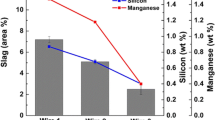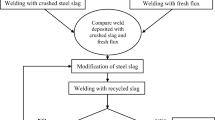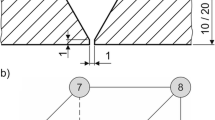Abstract
In the automotive industry, it is essential to reduce the weight of the car body to improve fuel efficiency and reduce CO2 gas emissions. As such, the application of advanced high-strength steels is rapidly increasing. However, in the case of gas metal arc (GMA) welding of advanced high-strength steels (AHSS), slag particles are observed to form on the weld surface resulting in poor corrosion resistance. The presence of slag particles on the weld also affects mechanical performance. This paper focuses on the degradation of corrosion resistance due to these slag particles. Current methods to decrease slag islands are costly as they attempt (1) to better protect the weld pool by decreasing the content of oxygen-containing ingredients or increasing argon in the shielding gas and (2) to mechanically clean the weld surface using processes such as shot blasting after gas metal arc welding (GMAW). In this study, the amount of slag was reduced by adjusting the chemical composition of welding consumables. Silicon was decreased to minimize silica/silicate formation, and sulfur was adjusted to affect the surface tension balance of the molten pool. Slag particles were observed to flow along the welding direction to solidify into a large particle in the weld crater that could be removed easily. In a separate consumable, Si and Mn contents were adjusted to form Mn3O4 and SiO2 slag. The use of these two welding consumables reduced the amount of slags, which improved the corrosion resistance. It is not the intent of this paper to compare the performance of these two experimental consumables, however.








Similar content being viewed by others
References
Kuziak R, Kawalla R, Waengler S (2008) Advanced high strength steels for automotive industry. Arch Civ Mech Eng 8(2):103–117
Matlock DK, Speer JG, De Moor E, Gibbs PJ (2012) Recent developments in advanced high strength sheet steels for automotive applications: an overview. JESTECH 15(1):1–12
Shome M, Tumuluru M (2015) Introduction to welding and joining of advanced high-strength steels (AHSS). Welding and Joining of Advanced High Strength Steels (AHSS) edited by Mahadev Shome, Muralidhar Tumuluru:1–8
Kah P, Pirinen M, Suoranta R, Martikainen J (2014) Welding of ultra high strength steels. Adv Mater Res 849:357–365
Kim JH, Frost RH, Olson DL (1998) Electrochemical oxygen transfer during direct current arc welding. Weld J 77(12):488s–494s
Kim JH (1987) Effect of electrochemical reactions on the weld metal chemistry during the direct current submerged arc welding process. Colorado School of Mines M.S. Thesis
Kim JH, Frost RH, Olson DL, Blander M (1990) Effect of electrochemical reactions on submerged arc weld metal composition. Weld J 69(12):446–453
Sullivan EM, Derrien R, Moine E, Briand F (2020) Silicate island formation in gas metal arc welding. Accepted for publication in the Welding Journal Research Supplement, MS 202910282, April 3
Onsøien MI, Liu S, Olson DL (1995) Shielding gas oxygen equivalent in weld metal microstructure optimization. Weld J Res Suppl 75(7):216 s–224 s
Derrien (2011) Understanding of the formation of silicate islands in GMAW. Colorado School of Mines, M.S. Thesis
Kou S, Limmaneevichitr C, Wei PS (2011) Oscillatory Marangoni flow: a fundamental study by conduction-mode laser spot welding. Weld J 90(12):229s–240s
Hasegawa M, Watabe M, Young WH (1981) Theory of the surface tension of liquid metals. J# Phys F Met Phys 11(8):173–177
Chacon E, Flores F, Navascues G (1984) A theory for liquid metal surface tension. J Phys F Met Phys 14(7):1587–1601
Heiple CR, Roper JR, Stagner RT, Aden RJ (1983) Surface active element effects on the shape of GTA, laser, and electron beam welds. Weld J 62(3):72s–77s
Wang Y, Tsai HL (2001) Effects of surface active element on weld pool fluid flow and weld penetration in gas metal arc welding. Metall Mater Trans B Process Metall Mater Process Sci 32(3):501–515
Ahsan Md RU, Cheepu M, Ashiri R, Kim TH, Jeoung C, Park YD (2017) Mechanism of weld pool flow and slag formation location in cold metal transfer (CMT) gas metal arc welding (GMAW). Weld World 61(6):1275–1285
Umehara Y, Suzuki R, Nakano T (2009) Development of the innovative GMA wire improving the flow direction of molten pool. Q J Jpn Weld Soc 27(2):163 s–168 s
Fujimoto H, Akioka K, Tokunagr M (2018) Improvement of corrosion properties after electrodeposition of arc welds in automotive steel sheets by shot blasting. Nippon steel & sumitomo metal technical report
Fujimoto H, Akioka K, Tokunaga M (2017) Effects of shot blasting on corrosion properties after electrodeposition and fatigue properties of arc welds in automotive steel sheets. Mater Trans 58(12):1715–1720
AWS A5.18/A5.18M, 7th Edition (2017) Specification for carbon steel electrodes and rods for gas shielded arc welding, published by American Welding Society, Inc. (AWS)
ASTM D6899 (2010) 2003 Edition, July 10, 2003 - Standard guide for laboratory cyclic corrosion testing of automotive painted steel, published by ASTM International (ASTM)
Acknowledgment
The authors wish to acknowledge KISWEL R&D Center staff for their useful discussion.
Funding
The authors received support from the KISWEL Ltd., for the completion of this work.
Author information
Authors and Affiliations
Corresponding author
Additional information
Publisher’s note
Springer Nature remains neutral with regard to jurisdictional claims in published maps and institutional affiliations.
Recommended for publication by Commission II - Arc Welding and Filler Metals
Rights and permissions
About this article
Cite this article
Lee, Y., Jang, J. & Liu, S. Effect of chemical composition of welding consumable on slag formation and corrosion resistance. Weld World 65, 373–380 (2021). https://doi.org/10.1007/s40194-020-01059-y
Received:
Accepted:
Published:
Issue Date:
DOI: https://doi.org/10.1007/s40194-020-01059-y




